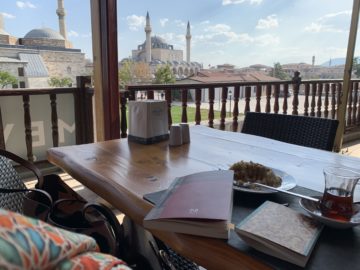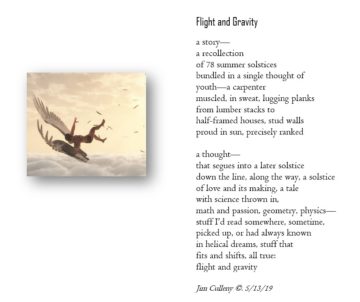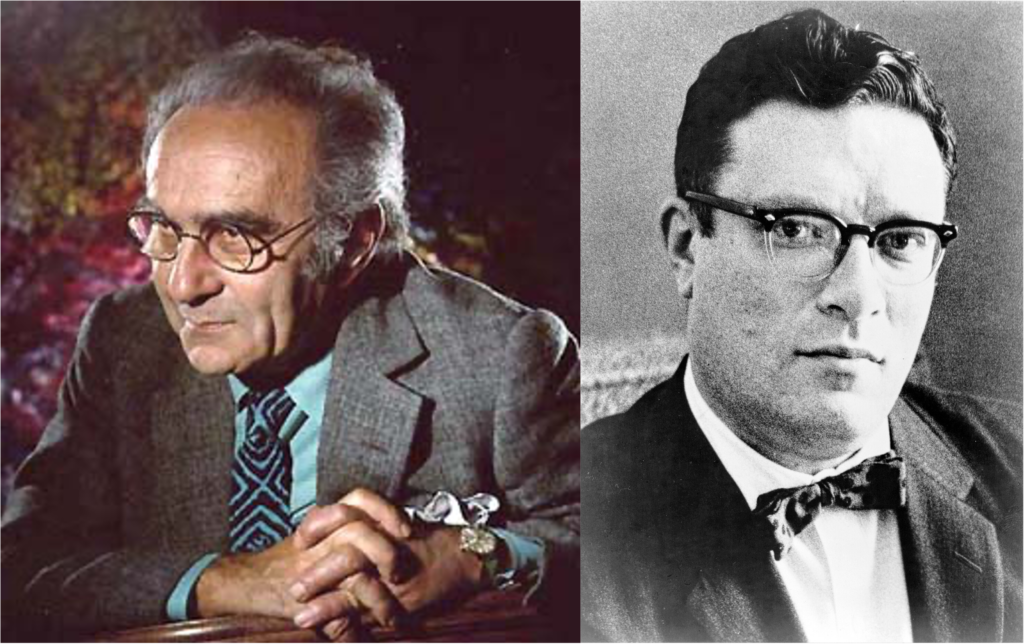
Monday Poem


by Rafaël Newman
I am not outside the language that structures me, but neither am I determined by the language that makes this ‘I’ possible. —Judith Butler
 The force of recent attempts to increase minority visibility in the performing arts, principally in the US, by matching the identity of the performer with that of the role—in effect a form of affirmative action—has been diminished by a series of tabloid “scandals”: the casting of Jared Leto as a trans woman in Dallas Buyers Club criticized as “transmisogynistic”; the backlash against the non-Jewish Helen Mirren playing Golda Meir; or the foofaraw over Bradley Cooper’s prosthetic proboscis in Maestro. These attempts to increase minority visibility, no doubt well-meaning and long overdue, were taken ad absurdum with the Met’s 2019 choice of a Chinese soprano for the title role in Madama Butterfly, in a cringingly tone-deaf bid to make up for the tradition of Westerners singing the eponymous Japanese heroine.
The force of recent attempts to increase minority visibility in the performing arts, principally in the US, by matching the identity of the performer with that of the role—in effect a form of affirmative action—has been diminished by a series of tabloid “scandals”: the casting of Jared Leto as a trans woman in Dallas Buyers Club criticized as “transmisogynistic”; the backlash against the non-Jewish Helen Mirren playing Golda Meir; or the foofaraw over Bradley Cooper’s prosthetic proboscis in Maestro. These attempts to increase minority visibility, no doubt well-meaning and long overdue, were taken ad absurdum with the Met’s 2019 choice of a Chinese soprano for the title role in Madama Butterfly, in a cringingly tone-deaf bid to make up for the tradition of Westerners singing the eponymous Japanese heroine.
A salutary, if ironic corrective to this essentialism is offered by casting members of “minority” groups—the term is (mis)used advisedly to include women—explicitly against type: Denzel Washington as Macbeth, for instance, or Glenda Jackson as King Lear. Ironic, because such creative, intentional miscasting replicates the very misprision criticized on the part of the hegemon, which allegedly seeks to reserve privilege to its own replicants at the cost of the subaltern. The maneuver is salutary, however, both morally and aesthetically, because it proactively rights a wrong of exclusion, while opening up new avenues for the interpretation of established works of art. Once such a creatively “wrong” choice is made, in other words, and a given Western canonical work is no longer the account of a particular (most often white, cis-male, hetero) subject, it becomes—although the term is regularly subject to post-structuralist suspicion—universal. And finally, by playing the hegemon, the subaltern reveals the political and linguistic constructedness of that hegemon’s subject position.
These were among the thoughts that preoccupied me as I prepared for a house concert last month with my friends Annina Haug and Edward Rushton. Read more »
by Gus Mitchell
 1.
1.
Art comes out of act. The act of making images, of making sounds, the act of making words and symbols. And these “acts” are really accretions, many individual “actions”, acts in a process, acts which don’t often seem like “acts” at all. The acts of doodling, of scribbling, of sketching, of humming, of reading, looking, listening, playing, feeling, thinking, sitting, talking, walking.
2.
The Greek verb artizein means “to prepare”. Aside from an obvious etymological reading––a work of art is something that has been fitted together by “skill” or “craft” implied in the Latin artem. The making of art, any art, means to engage in an incalculability of acts of preparation.
3.
“To prepare”, though, carries the sense of a forethought and foreseen nature to the act which is very often not part of the artistic process. We don’t know what we’re doing, a great deal or the time; at others, we don’t even know what we want. And if we do happen to have an idea before us, a definite plan to carry out, then we just has often have no sense of how to get there. None.
4.
This is where preparation meets iteration. If “art” as an act only arises out of and ultimately consists of preparations, it is then true that the “work of art” (a product and evidence of learning, skill, craft, and tradition) is the child of iteration. That is, of doing again. And again, and again and again.
5.
If nature’s glory and mystery is in its effortlessness, its spontaneity, what Daoism calls Ziran (“that which arises of itself”) then perhaps we might claim ours in sheer and bloody effort. (Beethoven, Nina Simone.) Read more »
by Terese Svoboda
 How plastic – really plastic – gelatin presents as a food. Not only in the “easily molded” sense of a pliable art material but also its transparency. Walnuts and celery, the “nuts and bolts” of gelatin desserts, defy gravity, floating amidst the cheerful jewel-like plastic-looking splendor of the 1950’s, when gelatin was the king of desserts. Gelatin’s mid-century elegance belies its orgiastic sweetness, especially the lime flavor, which is downright otherworldly. If you stir it up hot, half diluted, gelatin lives up to its derelict reputation with regard to the sickbed and sugar, being thick and warm, twice as intoxicatingly sweet, and surely terrible for an invalid’s teeth, if not metabolism. In my novel, Dog on Fire, I hypothesize that lime-flavored gelatin is the perfect murder weapon.
How plastic – really plastic – gelatin presents as a food. Not only in the “easily molded” sense of a pliable art material but also its transparency. Walnuts and celery, the “nuts and bolts” of gelatin desserts, defy gravity, floating amidst the cheerful jewel-like plastic-looking splendor of the 1950’s, when gelatin was the king of desserts. Gelatin’s mid-century elegance belies its orgiastic sweetness, especially the lime flavor, which is downright otherworldly. If you stir it up hot, half diluted, gelatin lives up to its derelict reputation with regard to the sickbed and sugar, being thick and warm, twice as intoxicatingly sweet, and surely terrible for an invalid’s teeth, if not metabolism. In my novel, Dog on Fire, I hypothesize that lime-flavored gelatin is the perfect murder weapon.
I considered many modus operandi, starting with freezing it into the shape of a dagger. However, such a weapon would quickly dissolve into a lime green, mellow yellow or ruby red puddle or, if undyed, at least clear gelid water, and its penetration would definitely leave a hole. Concuss the victim with gallons of gelatin dropped from a height? The abovementioned puddle would give it away, not to mention the victim’s crushed skull. Both methods could be accomplished with more simpler tools. The only totally invisible murder method is past the taste buds: poison-by-gelatin. This has two positive attributes as a murder weapon: it leaves no physical marks and its results can be somewhat timed. Ah, but the autopsy. Surely that would reveal the poison.
Not always. Read more »
by Marie Snyder

For decades I taught a course, the Challenge of Change in Society, which used the lens of social sciences to try to understand world issues and explore how we ended up with our current challenges and how to enact change. I taught about how media provokes consumerism and how to counter that, and why to counter that, in our daily lives for the sake of the planet, the people, and our own well being. I often stepped outside of the social sciences to draw on thousands of years of philosophies and religions that have understood that happiness isn’t the result of an accumulation of things.
I practice what I preach for the most part. Curiously, though, by about mid-July each year, I’d forget everything I had been teaching and end up on a shopping spree until I’d come to my senses. Ten years ago I wrote about how much I need government policies to restrain my habits – that we all do – or else we’ll literally shop ’til we drop, as a species, which is happening before our eyes.
 Barring that reality, and knowing this would be an ongoing, lifelong issue, I got a tattoo on my Visa-paying forearm to remind myself that my actions affect the entire world. I borrowed Matisse’s Dance and have the characters circling a re-forming pangea. We need to come together on this, collectively, to reduce ongoing suffering. Read more »
Barring that reality, and knowing this would be an ongoing, lifelong issue, I got a tattoo on my Visa-paying forearm to remind myself that my actions affect the entire world. I borrowed Matisse’s Dance and have the characters circling a re-forming pangea. We need to come together on this, collectively, to reduce ongoing suffering. Read more »
by Paul Braterman
The Heartland Institute tells us that there is not, and cannot be, a climate crisis, because for most of the past 12,000 years the climate was warmer than it is today. A recent (October 5) posting by James Taylor, president of the Institute, states as follows (full text; fair use claimed):
CLIMATE CHANGE: The so-called climate crisis is a sham
There cannot be a climate crisis when temperatures are unusually cool.
- Scientists have documented, and even the United Nations Intergovernmental Panel on Climate Change has admitted, that temperatures were warmer than today throughout most of the time period that human civilization has existed.
- Temperatures would have to keep warming at their present pace for at least another century or two before we reach temperatures that were common during early human civilization.
- There can be no climate crisis – based on the notion of dangerously high temperatures – when humans have thrived in temperatures much warmer than today for most of the last 12,000 years.
None of this is true. Here is a graph of climate change in the past 12,000 years; note the value for 2016, on the right-hand axis of the main figure, as well as the rapid rise over the past century shown in the inset, which also shows the Mediaeval Warm Period and the Little Ice Age. I have seen Heartland’s claim before, accompanied by graphs such as the one below, but without the insert and recent date, thus effectively suppressing everything that’s happened in the last century:

For people familiar with the Heartland Institute, this is just a dog bites man story. But it still matters, because it shows the extent to which discourse is being deliberately degraded. Read more »
by Brooks Riley

by Akim Reinhardt and A Nother
 I am sitting on the couch of our discontent. The Robot Overlords™ are circling. Shall we fight them, as would a sassy little girl and her aging, unshaven action star caretaker in the Hollywood rendition of our feel good dystopian future? Shall we clamp our hands over our ears, shut our eyes, and yell “Nah! Nah! Nah! Nah! Nah!”? Shall we bow down and let the late stage digital revolution wash over us, quietly and obediently resigning ourselves to all that comes next, whether or not includes us?
I am sitting on the couch of our discontent. The Robot Overlords™ are circling. Shall we fight them, as would a sassy little girl and her aging, unshaven action star caretaker in the Hollywood rendition of our feel good dystopian future? Shall we clamp our hands over our ears, shut our eyes, and yell “Nah! Nah! Nah! Nah! Nah!”? Shall we bow down and let the late stage digital revolution wash over us, quietly and obediently resigning ourselves to all that comes next, whether or not includes us?
Or shall we turn fate inside out?
I’ll see your for-now mistake-prone, mechanical-sounding AI text wrapped in perfect grammar, spelling, and syntax, and raise you a heaping portion of human word salad.
I will confront our looming destiny, an endless stream of tyrannical 1s and 0s, and counter it with a pale imitation of the worst that 20th century modernism had to offer: crippled, meandering stream of consciousness threaded together by not one, but two fleshy humans, one sitting and soaked through with the hot runoff of high end espresso beans, the other bedraggled, stained, and standing, each of them hypocritically and simultaneously composing on a share word processing document made possible only by the forerunners of tomorrow’s masters: the processors and software we still treat, at least for now, like slaves, lashing them with mechanical keystrokes and mouse swipes. Read more »
Oh, Ariela, daughter of the People of the Book, the work of the mind is our game!
–Miriam Yevick
 I first became aware of Miriam Lipschutz Yevick through my interest in human perception and thought. I believed that her 1975 paper, Holographic or Fourier Logic, was quite important. David Hays and I gave it a prominent place in our 1988 paper, Principles and Development of Natural Intelligence, and in a related paper on metaphor.
I first became aware of Miriam Lipschutz Yevick through my interest in human perception and thought. I believed that her 1975 paper, Holographic or Fourier Logic, was quite important. David Hays and I gave it a prominent place in our 1988 paper, Principles and Development of Natural Intelligence, and in a related paper on metaphor.
Since Yevick’s work shares a mathematics with some work in machine vision and image recognition, I wondered whether or not that paper had been cited. Moreover, that work is relevant to current debates about the need for symbolic processing in artificial intelligence (AI). As recently as 2007 Yevick was arguing, albeit informally, that human thought requires both poetic, Gestalt, or holographic processing, on the one hand, and analytic, propositional, or logical on the other.
As far as I can tell, her work has been forgotten.
That is one thing. But there is more. I become curious about her, this woman, Miriam Lipschutz Yevick.
What about her? And so I began reading her 2012 memoire, A Testament for Ariela, which takes the form of letters she had written to her grand-daughter in a three-year period in the mid-1980s. The memoire says nothing about her mathematical ideas, though it does mention that in 1947 she became the fifth woman to get a mathematics Ph.D. from MIT. She also talks of her friendship and correspondence with David Bohm, who became a noted quantum theorist. It quickly became clear that she had not had an academic career worthy of her intellectual gifts. Yet she did not seem bitter about that. She had a rich and fulfilling life.
This essay is about both her life and her holographic logic. The work on holographic logic leads me to a harsh assessment of the current debate about artificial intelligence. Thinking about her life leads me to conclude with an optimistic look at the future: next year in Jerusalem. Read more »
by Angela Starita
When I moved into my new neighborhood, I was anxious to the point of nausea. Even today, the soap my husband and I used to clean the kitchen when we first arrived induces a nervous sadness, the feeling of a no-turning-back crisis. But this was one I’d brought upon myself. We’d moved from a wonderful 2-bedroom apartment overlooking the campus of an art school in the now idealized landscape of Brownstone Brooklyn, and that treasure in the currency of New York City real estate, just two blocks from the subway. But I wanted more space and a chance to garden. I got that in a house in Kensington, about five miles south of my old place, but culturally at a complete remove. Kensington is a world of immigrants and Hasidic Jews, row houses and dozens of brick apartment buildings along a road that runs straight to Coney Island. That last, Ocean Parkway, was the idea of the great Olmsted and Vaux of Central Park fame, and it had been an esteemed address at one time. (While I suspected this from the architecture of some of the older buildings, my hunch was confirmed when I heard an interview with David Geffen describing his childhood ambition to one day have an apartment on Ocean Parkway. It should be noted, that Geffen said this to demonstrate what a parochial world view he’d had as a young man.) The neighborhood’s eastern boundary, Coney Island Avenue, is overrun with car repair shops almost as desolate as F. Scott Fitzgerald’s Valley of the Ashes. Read more »
by Shadab Zeest Hashmi
 At dusk, the shaft of light striking Rumi’s tomb is emollient as pale jade. It has been a long, hot day in Konya, I’ve been writing in a café-terrace overlooking the famed white and turquoise structure of the tomb-museum complex. I sip my tea slowly, facing the spare, elegant geometry of the building that appears as a simple, intimate inscription on the vast blue. For once I am studying Rumi’s verses in Persian, not repeating English translations or paraphrasing in Urdu. “Bash cho Shatranj rawan, khamush o khud jumla zaban,” “Walk like a chess piece, silently, become eloquence itself!” I’m reciting to myself in the din, in awe of the kind of magnetism that would pull one as a chess piece. Only the heart understands this logic, not any heart, but the one that has been broken open, the one that is led to the mystery in cogent silence.
At dusk, the shaft of light striking Rumi’s tomb is emollient as pale jade. It has been a long, hot day in Konya, I’ve been writing in a café-terrace overlooking the famed white and turquoise structure of the tomb-museum complex. I sip my tea slowly, facing the spare, elegant geometry of the building that appears as a simple, intimate inscription on the vast blue. For once I am studying Rumi’s verses in Persian, not repeating English translations or paraphrasing in Urdu. “Bash cho Shatranj rawan, khamush o khud jumla zaban,” “Walk like a chess piece, silently, become eloquence itself!” I’m reciting to myself in the din, in awe of the kind of magnetism that would pull one as a chess piece. Only the heart understands this logic, not any heart, but the one that has been broken open, the one that is led to the mystery in cogent silence.
For once, I am letting the music of Rumi’s diction guide me: “khamush” (silent) and “khud” (self), a sonic coaxing of paradox, two words beginning with the same consonant, the first ending in “sh’, a sound that evokes the hushing of the ego’s voice, the softly-fading whisper of self-annihilation, the second ending as a sonic anchor in “ud,” suggesting the triumph of the self as it sheds worldly desires, alchemizing from base to the gold it was meant to be. This meditation yields the word “khuda” or “God,” who is paradoxically both “closer than the jugular vein” and a “hidden treasure,” in the words of the Qur’an, to be revealed actively, painstakingly in the hidden recesses of the self– as Rumi and the Sufi tradition teach. The divine resides in the self’s silences and music, solitude and communion, longing and ecstasy. Rumi’s path to love passes through such paradox; to be a Darwish, is to “linger by the door,” content to make a home of the beloved’s threshold where he gives himself up to gnosis through praise. Read more »
by Tim Sommers

In honor of “Reading Hume Today,” a conference honoring professor Elizabeth Radcliffe and her work on Hume, here at my new home, the College of William and Mary, I thought I would read Hume today and revisit the topic of my very first 3 Quarks Daily article over five years ago, “Two Sources of Objectivity in Ethics.” (I also highly recommend Massimo Pigliucci’s essay responding to that piece.) However, if you just can’t wait to find out why Hume was in favor of gossip you can scroll down to the last few paragraphs.
What I want to talk about, and find endlessly interesting, is why David Hume, the fourth greatest philosopher of all time, thought morality must be subjective. Every time I return to it, I manage somehow to be surprised by his argument. In particular, what’s striking (to me) is that his argument is based on motivation. Morality must be subjective, he says, otherwise it couldn’t motivate us to action.
In Book II, Part III, Section III of his Treatise on Human Nature (subtitled, “Being an Attempt to Introduce the Experimental Method of Reasoning into Moral Subjects”), Hume sought to put an end “to talk of the combat of passion and reason.” “Reason is, and ought only be,” he famously proclaimed, “the slave of the passions”. He makes a number of striking claims in this section that epitomize this view. Perhaps, most shockingly he says, “It is not contrary to reason to prefer the destruction of the whole world to the scratching of my finger.”
Here’s his line of reasoning, I think. (As befits the fourth greatest philosopher of all time there are many, many other readings of Hume.) Read more »
by Jonathan Kujawa

The most fundamental example of a function is a polynomial. Everyone sees polynomials in school. These are the functions whose rules involve taking the input to powers, perhaps multiplying by numbers, and perhaps doing some additions and subtractions. For example,
![]()
Here the input variable is x. When you input x= 2 or x=1 or x=-1, you get p(2)=3, p(1)=2, and p(-1)=6 as outputs.
You may recall that a zero (or root) of a polynomial is the name for an input that happens to give you zero as an output. For example, the polynomial x² – 4x + 3 has zeros x=1 and x=3. On the other hand, the polynomial p(x) doesn’t seem to have any zeros.
Many applications in and out of math come down to the question of finding the zeros of a polynomial. Several years ago, we talked here at 3QD about how certain geometric constructions from Ancient Greece are impossible with ruler and compass, but become possible using origami. Under the hood, this came down to understanding the zeros of certain polynomials. Important parts of number theory and geometry are essentially about the problem of understanding the zeros of polynomials. Read more »

by Ashutosh Jogalekar

There are two kinds of science writers which I will call “artists” and “craftsmen”. Since I might face the opprobrium of both groups by attaching these labels to them, and especially because the two categories may overlap considerably, let me elaborate a little. Artists are big on literary science writing; craftsmen are big on explanatory science writing. Artists write beautiful prose; craftsmen write clear prose. Artists write relatively few books and are likely to win big book awards like the Pulitzer Prize; craftsmen are content to be merely prolific, often writing dozens or even hundreds of books.
Let me quote from a master craftsman of the trade to put the discussion into context. Isaac Asimov who wrote more than 500 books, seemingly on every subject conceivable, had the following to say about his writing style:
“I made up my mind long ago to follow one cardinal rule in all my writing—to be ‘clear’. I have given up all thought of writing poetically or symbolically or experimentally, or in any of the other modes that might (if I were good enough) get me a Pulitzer prize. I would write merely clearly and in this way establish a warm relationship between myself and my readers, and the professional critics—Well, they can do whatever they wish.”
Asimov wasn’t just a great science fiction writer but a great science writer. He was known as “The Great Explainer” for his ability to explain complex, sweeping scientific topics to laypeople. But Asimov’s quote above also illustrates a central dilemma of science writing. That dilemma was best captured by the physicist Paul Dirac when he expressed puzzlement to Robert Oppenheimer who he had befriended while the two were researchers at the University of Göttingen in the 1920s. Oppenheimer, a man with broad interests across science and the humanities, studied both physics and poetry. Befuddled, Dirac once asked him, “Oppenheimer, they tell me you are writing poetry. I do not see how a man can work on the frontiers of physics and write poetry at the same time. In science you want to say something that nobody knew before, in words which everyone can understand. In poetry it seems to be the opposite”. Dirac had a point. In science a tiger is a striped mammal and an apex predator. In poetry a tiger is a “tyger”, with an “immortal hand or eye framing thy symmetry”. Read more »
by Jerry Cayford
 “This is the story of a man. Not rich and powerful, not a big man like your father, Sweetheart. Just a funny little man. I didn’t know him long, only three nights. But there was something about him, something magical.” If “Rumpelstiltskin” started with this framing, we would have a different picture of the story’s meaning, a truer picture, for this framing suggests what is hidden below the surface.
“This is the story of a man. Not rich and powerful, not a big man like your father, Sweetheart. Just a funny little man. I didn’t know him long, only three nights. But there was something about him, something magical.” If “Rumpelstiltskin” started with this framing, we would have a different picture of the story’s meaning, a truer picture, for this framing suggests what is hidden below the surface.
The miller’s daughter is our “shadow” narrator. No one else witnesses the central events of the story, except Rumpelstiltskin, and he’s dead. We get suspicious that the story she’s telling makes her look too good: the beautiful victim, abused by everyone, who somehow ends up with the king, the gold, the servants, and the child, and never has to pay her debts. Clues pile up, starting from Rumpelstiltskin’s death. He “ripped himself up the middle in two” and sank into the earth. The poor sap killed himself. Why? We follow the trail of breadcrumbs. Why would the guy want the daughter’s firstborn? Sounds like a euphemism… That’s it! The bargain wasn’t for the child but for the woman! It’s the oldest bargain in the world. But if that was the deal… paydirt: Rumpelstiltskin is the child’s father!
There is plenty to uncover in this fairy-tale-noir story of illicit sex, betrayal, obsession, and suicide, but you have to believe it is worth digging. Perhaps if I tell you the story is older than the bible: “Rumpelstiltskin, in summary, is one of the earliest known narratives in Western literature” (Oliver Tearle). Scholars have traced the story back to languages long vanished. As Tearle puts it, “The story obviously has its roots deep in the most primal and basic drives and emotions which are commonly shared throughout humanity.” Read more »
by Chris Horner

Imagine you are put in regular close contact with someone who regularly makes your life difficult. This could be at work, or a flat share, anything. They leave you to finish the chores they start, invade your space, and generally act in an inconsiderate way. You’d like to put some space between them and you, but you can’t. Perhaps you’ve some choice words for them which you are preparing to share, but holding back your exasperation you try to point out to the person the problems they are causing. When you start to do that, this person responds by disclosing that they have a condition that, according to them, makes them act in this way. For our purposes this could be anything: ADHD, autism, PTSD, neurosis stemming from childhood neglect, bipolar – anything (to be clear: I am not suggesting that any of these are necessarily connected to antisocial behaviour; let’s also assume that they aren’t inventing the diagnosis, and that the condition is real). [1]
How does this change your feelings about the situation, if at all? Perhaps you try to talk through the situation to find a way to work with this person to mitigate the antisocial behaviour. But it continues. You might find a way of leaving the situation, or of getting outside assistance. You might check that there has been a legitimate medical diagnosis, all sorts of things. Suppose the condition has been diagnosed by a qualified person. So they do have this condition. Again: what has changed? Read more »